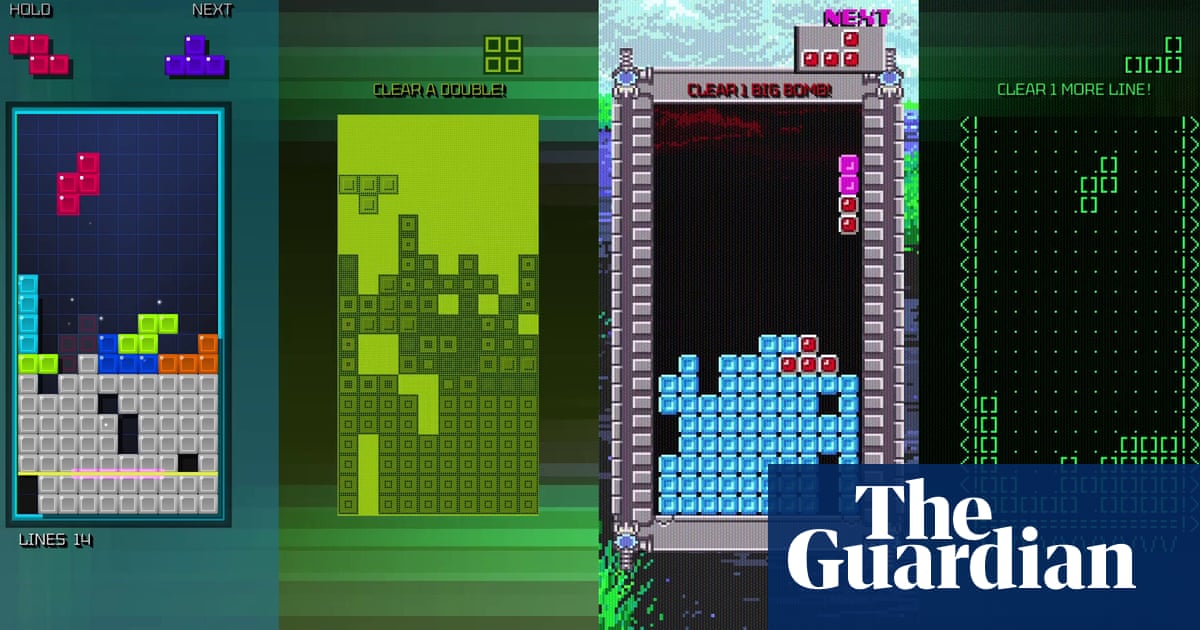Believe me when I say: I truly thought I knew the story of Tetris. The puzzle game’s journey from behind the iron curtain in 1980s Moscow to multi-million-selling video game has been the subject of countless articles, a greatly entertaining book and a recent film. I have played Tetris in various forms for more than 30 years, from the Game Boy to the Nintendo Switch, even in VR. So when I loaded up Tetris Forever, an interactive documentary on Tetris’s 40-year history from the developers-slash-archivists at Digital Eclipse, I wasn’t expecting to learn anything new. I was proven very wrong.
Did you know about Hatris, the 1990 Tetris follow-up that involved stacking colourful hats on top of heads? I did, vaguely, but I did not know about the semi-authorised twist on that game put out by Spectrum Holobyte the same year, a mildly horrifying swap-and-drop puzzler that had players stacking up mouths, noses and eyes to try to make human faces. They called it Faces…tris III, which suggests that whoever named it gave up halfway through. No wonder it wasn’t a hit. I didn’t know that Henk Rogers, the charismatic Dutch-American who played a huge part in turning Tetris into a global phenomenon, spent his student years surfing and diving in Hawaii before (his words) chasing a girl to Japan and coding the country’s first bestselling RPG in 1984.
Tetris Forever is comprised of five chapters, presented as timelines with an absolute treasure trove of images and video from Tetris’s 40-year history, and faithful, playable recreations of the game that show how it has evolved since Alexey Pajitnov coded the game as something to entertain himself while working in Moscow’s computer research centre. It’s a good four hours’ worth of stuff, at least. There’s camcorder footage from Henk’s famous visit to Moscow, where he turned up completely unauthorised at a Russian government building to fight for the rights to publish Tetris on the Game Boy. There’s fascinating footage from Nintendo of America in the 1980s, and photos of Henk and Pajitnov with the infamously hard-to-impress former Nintendo president Hiroshi Yamauchi, with whom Rogers struck up a fruitful business friendship over games of Go.
Alongside the 15 playable versions of Tetris from throughout its history, game boxes and adverts and marketing material are digitally recreated in perfect detail for you to examine and pan around. And of course, there’s plentiful on-camera interview footage – not just from Rogers and Pajitnov, but from the other people who played a part in Tetris’s history, too.
What emerges here is a much fuller picture of Tetris’s history than the Apple TV film, which glossed over quite a lot of detail, especially about the four-way scrap over the rights to Tetris in the 1980s. Here, no detail is spared. Admittedly this does turn the second and third chapters into a bit of a shaggy dog story, as we hear about every last detail, but when it comes to gaming history this detail is important even when it threatens to be boring. This all paints such an interesting portrait of the games industry in the 1980s, which in the US and Europe was truly a wild west of have-a-go coders and entrepreneurs – often coders themselves – shopping games around the place and occasionally getting very rich off them. This contrasts strongly with the situation in Japan, whose gaming scene was dominated by a few stiffly traditional companies with enormous respect for process, and of course with Russia and the Soviet Union, where it was straightforwardly forbidden to do any kind of business deal with a foreign company.
This might all sound terrifically nerdy and, well, it is – Digital Eclipse makes super comprehensive reissues that truly respect the history of the games involved. Tetris Forever is not a general-audience documentary, but one for people with a keen interest in gaming history. The playable versions of Tetris and other connected games, meanwhile, are impressively faithful, but obviously the versions that everyone really wants to play – the Game Boy and NES versions – remain within Nintendo’s vicelike grip. For what it’s worth, Tetris Effect is still the best version of Tetris in my opinion – it was made by Tetsuya Mizuguchi, famed Japanese developer of synaesthesic music games, who also appears a lot in this documentary footage.
Tetris has come to feel eternal, and there’s something almost spiritual about playing a recreation of its first version, made for the Electronika 60 computer out of square brackets and exclamation marks lined up on a flickering black-and-green screen. Playing it, I feel a small echo of what I feel when I look at the Rosetta Stone in the British Museum. It is an amazing thing, a rare example of a perfect game that despite all the drama outlined in this documentary and all the various version over the years, is still pretty much unchanged after 40 years.

